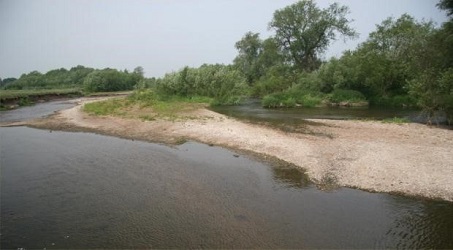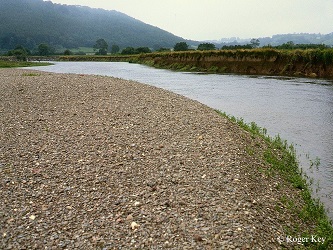Current ISIS code: W111
Previous assemblage name: W421 shingle banks.
Linked assemblage: W122 Riparian sand.
Description of habitat typically supporting the assemblage: This assemblage type is mainly characterised by terrestrial ground-living beetles.
This SAT is dependent on repeated turnover of coarse grained sediment by spates and so is sensitive to management of river channels, river catchments and changes in rainfall patterns. It seems to be sensitive to siltation. The larvae of many species are probably thermophilic, so it may also respond to temperature rise.
The assemblage type is found on exposed coarse-grained riverine sediments ranging from gravel to cobbles and small boulders.

In their natural habitat, assemblages depend on the resorting of sediment during periods of high flow, whose frequency and severity usually peak in the winter away from montane areas. Sparsely vegetated, freshly deposited sediment is exploited for breeding as water levels fall in the spring. Some species can also occur on exposed coastal or lacustrine shingle or in artificially disturbed sites such as gravel pits, but only in the early stages of vegetation succession.
Assemblages on large sedimentary bars in the piedmont zone tend to have a higher species richness than smaller bars on streams in the upper catchment. Some species such as Lionychus quadrillum and Coccinella quinquepunctata are often found higher up on the bank and tend to persist into later stages of ecological succession than those species restricted to freshly worked sediment.

Adults of larger species are active above ground, but spend resting periods within the sediment. Several species have flattened body forms to facilitate access underneath the surface. Smaller species can move through interstitial spaces in gravel. Larvae are presumed to be terrestrial and probably benefit from insolation of their habitat to aid development.
The larva of the diving beetle, Bidessus minutissimus, is aquatic. It is possible that its preference for remnant pools high up on shingle banks reflects a preference for warm water to facilitate development. Climate change can be expected to affect this assemblage type both through increased temperatures and changes in rainfall patterns.
Links to other conservation objectives: Climate change (rainfall, temperature, coastal erosion), river management.
Sampling & assessing the assemblage
Standard sampling protocols apply.
Target groups: Coleoptera, Heteroptera.
Fieldwork methods: Ground-searching, sweeping for diptera.
Alternative methods: Passive trap methods.
Season: Mid May-late June for beetles.
Discrimination of conservation quality: good
Default target: 9 species
